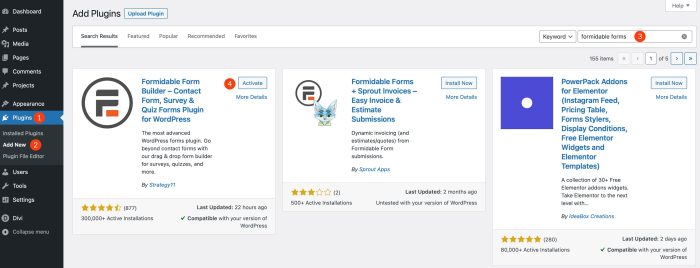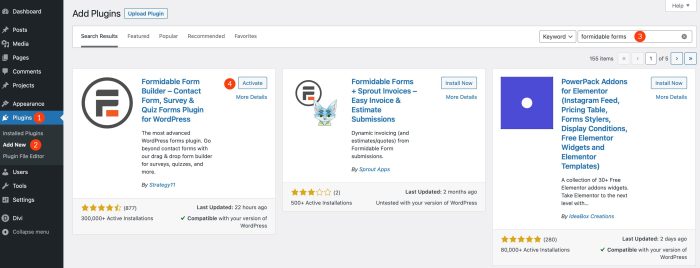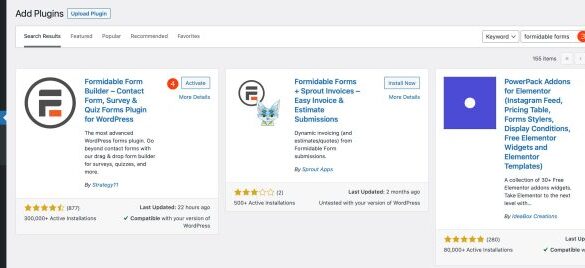How to create a survey in WordPress? This comprehensive guide walks you through every step, from choosing the perfect plugin to analyzing the results. We’ll explore various question types, customization options, and best practices to ensure your survey is engaging and effective for collecting valuable data on your WordPress site. Learn how to boost user engagement and gather insights effortlessly.
From simple multiple-choice questions to complex conditional logic, this guide will empower you to design and implement surveys that perfectly suit your needs. We’ll delve into the specifics of different plugins, making the process easier and more efficient.
Introduction to Surveys in WordPress
Surveys are a powerful tool for collecting valuable data and enhancing user engagement on your WordPress website. They allow you to understand your audience’s preferences, opinions, and needs, enabling you to tailor your content, products, and services to better meet their expectations. This can lead to increased customer satisfaction, improved website design, and more effective marketing strategies.Integrating surveys into your WordPress site provides a direct line of communication with your users.
This interaction fosters a sense of community and helps you build a stronger relationship with your audience. By understanding their perspectives, you can adapt your approach to resonate more effectively with their interests and needs.
Types of Surveys
Surveys can take various forms, catering to different needs and data collection objectives. Understanding the different types will help you choose the most suitable approach for your specific goals.
- Multiple Choice Questions: These questions present a set of predetermined options for respondents to choose from. This format is ideal for gathering quantifiable data on preferences and opinions. For example, asking users to select their preferred payment method or their preferred social media platform.
- Rating Scales: These surveys use numerical scales (e.g., Likert scales) to gauge the intensity of an opinion or attitude. For example, asking users to rate their satisfaction with a product or service on a scale of 1 to 5.
- Open-Ended Questions: These questions encourage respondents to provide detailed, descriptive answers in their own words. This approach is useful for exploring complex issues and gaining insights into the reasons behind specific choices. For instance, asking users to explain why they chose a particular product or service.
Enhancing User Engagement
Surveys can significantly improve user engagement on your WordPress site. Well-designed surveys can make the user experience more interactive and interesting, encouraging them to spend more time exploring your website.
- Interactive Experiences: Surveys can be integrated seamlessly into your website’s design, creating a more interactive experience for users. This can lead to greater engagement with your content.
- Data-Driven Decisions: The insights gained from surveys can inform decisions related to website design, content creation, and marketing strategies, leading to improvements in user experience and satisfaction.
- Building Community: Surveys can foster a sense of community among users, as they feel heard and valued. This interaction strengthens the bond between your site and its audience.
User Privacy and Data Security
Protecting user privacy and data security is paramount when designing and implementing surveys. Transparency and clear communication about data usage are essential to building trust.
- Transparency and Consent: Clearly communicate how you will use the collected data and obtain explicit consent from users before collecting any information. This will enhance trust and maintain user privacy.
- Data Security Measures: Employ appropriate security measures to protect sensitive data from unauthorized access and breaches. This includes using secure data storage and encryption methods.
- Compliance with Regulations: Adhere to relevant data privacy regulations (e.g., GDPR) to ensure legal compliance and uphold user rights.
Choosing the Right Survey Plugin
Picking the perfect WordPress survey plugin is crucial for creating effective and engaging surveys. The right plugin will streamline the process, enhance user experience, and provide the necessary tools to collect valuable data. Choosing a plugin involves considering factors like ease of use, customization options, and the specific features needed for your survey goals.Different survey plugins offer various functionalities, and understanding these differences is key to making an informed decision.
Features such as question types, reporting options, and integration with other WordPress tools will significantly influence your survey creation and analysis capabilities. A comprehensive understanding of the available options ensures your chosen plugin effectively supports your survey needs.
Popular WordPress Survey Plugins
Several plugins cater to the diverse needs of WordPress users. Popular choices include WPForms, SurveyMonkey, and Gravity Forms. These options represent a spectrum of functionality and pricing models, allowing users to choose the best fit for their projects.
Creating surveys in WordPress can be surprisingly straightforward. You’ll want to consider the overall strategy behind your survey, like focusing on clear goals and desired outcomes. For example, understanding 8 important content strategy goals to consider, like audience engagement and brand building, 8 important content strategy goals to consider , can greatly improve your survey’s impact.
Once you’ve defined your goals, you can select the right WordPress plugin to easily build your survey. This will help you gather valuable feedback from your audience.
Comparing Features and Functionalities
- WPForms: Known for its user-friendly interface, WPForms offers a wide range of form types, including surveys. It provides various question types, robust reporting tools, and seamless integration with other WordPress features. The plugin’s drag-and-drop functionality makes it easy to design complex surveys without extensive coding knowledge. A free version exists, but more advanced features and support are typically found in the paid plans.
- SurveyMonkey: This plugin leverages the well-known SurveyMonkey platform. It allows users to create professional-grade surveys with advanced features, including branching logic and complex question types. The reporting capabilities are comprehensive, and the integration with other SurveyMonkey tools makes data analysis efficient. However, SurveyMonkey plugins often come with a subscription model, with prices varying based on the plan chosen.
- Gravity Forms: Gravity Forms is a powerful form builder plugin capable of handling surveys. It’s highly customizable and flexible, allowing for intricate survey designs. It supports numerous question types and offers extensive reporting options, including detailed statistical breakdowns. Gravity Forms is often a premium choice, offering a range of pricing tiers to suit different project needs.
Pricing Models and Considerations
Understanding the pricing models of different plugins is essential. Free plugins often come with limited features and support, while paid plugins often provide more comprehensive functionalities and technical assistance. Free plugins can be sufficient for basic surveys, but advanced features and robust support are often found in paid versions. Consider the complexity of your survey and the resources you require to determine the appropriate pricing model.
Ease of Use and Customization
The ease of use and customization options offered by survey plugins significantly influence user experience. Intuitive interfaces and drag-and-drop functionalities facilitate survey creation, while extensive customization options enable the creation of surveys that align precisely with specific project needs. Consider the level of customization required and the time constraints involved when evaluating different plugins.
Setting Up a Survey in WordPress
Once you’ve chosen the perfect survey plugin for your WordPress site, the next step is installation and configuration. This involves several crucial steps to ensure your survey functions seamlessly within your website’s structure. Follow these steps carefully for a smooth implementation process.A well-configured survey is a powerful tool for gathering valuable insights from your audience. Proper setup and question design are key to maximizing the effectiveness of your survey and obtaining meaningful results.
Installing and Activating the Plugin
The installation process typically mirrors that of other WordPress plugins. Download the chosen plugin file from the plugin repository. Upload the plugin file to your WordPress media library, then navigate to the “Plugins” section in your WordPress dashboard. Locate the “Add New” button and click it. Choose the “Upload Plugin” option, select the downloaded file, and click the “Install Now” button.
After successful installation, activate the plugin by clicking the “Activate” button.
Creating a New Survey
After activating the plugin, you’ll usually find a dedicated survey creation section within your WordPress dashboard. Look for a menu item related to surveys or a button labeled “Add New Survey.” This will open the plugin’s interface for survey design. This interface typically provides options for naming your survey, selecting its purpose, and setting its initial parameters. Understanding these options is critical to effectively managing the survey and its response collection.
Designing Survey Questions
The core of any survey lies in its questions. The plugin’s interface usually allows you to select various question types. Common types include multiple-choice, short answer, rating scale, and more. Each question type offers unique possibilities for gathering different kinds of information. Careful consideration of question type will ensure that the survey effectively collects the data you need.
Adding Options to Multiple-Choice Questions
For multiple-choice questions, you’ll need to specify the different response options. Enter the text for each option, and in many cases, you can even assign weights or scores to the answers. This process allows you to tailor the question to your specific needs. For instance, you might need to categorize responses, such as “Strongly Agree,” “Agree,” “Neutral,” “Disagree,” “Strongly Disagree.”
Creating Survey Questions

Crafting effective survey questions is crucial for obtaining meaningful and reliable data. A well-designed survey goes beyond simply asking questions; it requires careful consideration of the wording, format, and structure to elicit accurate responses and avoid bias. This section dives into the art of creating survey questions, exploring different question types and strategies for maximizing the value of your survey.
Designing Effective Question Types
Creating a comprehensive survey involves carefully selecting the appropriate question types to gather the necessary information. The choice of question type directly impacts the quality and reliability of the data collected. A well-structured survey uses a variety of question types to cater to different kinds of information.
| Question Type | Question Text Example | Possible Answers |
|---|---|---|
| Multiple Choice | What is your preferred method of communication? | Email, Phone Call, Text Message, Social Media |
| Rating Scale | How satisfied are you with our customer service? | Very Dissatisfied, Dissatisfied, Neutral, Satisfied, Very Satisfied |
| Open-Ended | What are your thoughts on our new product? | (Open response, no predefined answers) |
Formulating Clear and Concise Questions
Clear and concise questions are essential for obtaining accurate and reliable data. Vague or ambiguous questions can lead to misinterpretations and inaccurate responses. Carefully crafted questions ensure respondents understand the intent behind each question, minimizing potential for errors.
Creating surveys in WordPress is surprisingly straightforward. You can find various plugins that make the process a breeze. And remember, if you’re feeling stuck or overwhelmed, just know that you’ve got support resources like ill be there for you to help you navigate the complexities of online surveys. Ultimately, with the right tools, you’ll be collecting valuable data in no time.
- Avoid using jargon or technical terms that respondents may not understand. Instead, use simple and straightforward language that everyone can easily grasp.
- Keep questions focused and avoid asking multiple questions in a single item. This ensures that respondents are answering only what’s asked, promoting clarity.
- Ensure that questions are specific and unambiguous. Avoid questions that can be interpreted in multiple ways.
- Use neutral language. Avoid leading questions that suggest a particular answer.
Incorporating Different Question Types
Different question types cater to diverse needs. Multiple-choice questions are suitable for collecting data on specific preferences or opinions. Rating scales provide a structured way to gauge levels of satisfaction or agreement. Open-ended questions allow for more in-depth responses, uncovering nuanced perspectives and insights.
- Multiple Choice: These questions present a set of predefined options, allowing respondents to select the most appropriate response. A good example is asking about preferred shopping methods. This question type is best for gathering categorical data.
- Rating Scales: These questions use a scale to measure opinions or attitudes. For example, asking respondents to rate their satisfaction on a scale of 1 to 5. This is helpful in measuring the intensity of an opinion.
- Open-Ended: These questions allow respondents to answer in their own words, providing a rich source of qualitative data. For instance, asking for feedback on a product or service. This helps uncover more detailed insights and allows for a more conversational approach.
Structuring Questions for Desired Information
The structure of questions plays a critical role in gathering the desired information. Questions should be organized logically, flowing from general to specific topics. This ensures a smooth and coherent survey experience for the respondent, leading to more accurate responses.
- Start with general questions to understand the respondent’s background or context.
- Gradually move towards more specific questions as the survey progresses.
- Organize questions logically and group related questions together to maintain a natural flow.
Formatting and Styling Surveys: How To Create A Survey In WordPress
Giving your WordPress survey a polished look and feel is crucial for encouraging participation and gathering reliable data. A visually appealing survey is more likely to be completed in its entirety, minimizing incomplete responses and improving the quality of your collected information. The right formatting and styling choices will also enhance the user experience and ensure your survey aligns with your brand identity.A well-designed survey streamlines the user journey and reduces potential frustrations, leading to higher response rates.
Clear formatting and branding help respondents quickly understand the survey’s purpose and structure. This creates a positive experience that makes participants more likely to complete the survey accurately.
Visual Styles for Survey Questions and Answers
Different visual styles can be employed to create engaging and informative survey questions and answers. Presenting questions in a variety of formats helps keep the respondent interested and prevents the survey from feeling monotonous. A visually engaging survey improves the overall user experience, leading to higher completion rates.
| Style | Description | Example |
|---|---|---|
| Bold Text | Use bold text for headings or important questions to highlight them. | What is your preferred method of communication? |
| Italicized Text | Italicize text for emphasis or to provide additional context to questions. | How satisfied are you with our recent product update? |
| Colored Text | Use different colors to differentiate question types or to draw attention to specific instructions. | Please rate your overall satisfaction. |
| Bullet Points | Present options in bullet points for better readability and to visually separate choices. |
|
| Numbered Lists | Use numbered lists for sequential or hierarchical questions. |
|
Customizing Survey Appearance and Branding
The survey’s appearance should align with your website’s design and brand identity. Consistent branding enhances recognition and builds trust. A visually cohesive survey improves the user experience, leading to higher response rates.
- Theme Integration: Using the same color scheme, fonts, and logo as your website creates a seamless user experience. This reinforces brand consistency and helps participants feel comfortable completing the survey.
- Custom CSS: For more advanced customization, you can use CSS to alter the styling of specific elements within the survey. This allows you to precisely match the survey’s look to your website’s design and maintain a consistent brand experience.
- Logo Inclusion: Including your logo in the survey header adds a touch of professionalism and helps respondents recognize the source of the survey.
Incorporating Images and Multimedia
Using images or multimedia elements within survey questions can enhance comprehension and engagement. Visual aids make surveys more interactive and can aid in understanding complex concepts.
Creating surveys in WordPress is pretty straightforward, but did you know that using Google Fonts can sometimes raise privacy concerns? To ensure your survey is compliant, you might want to consider how to make Google Fonts privacy friendly, like the methods outlined in this helpful guide: how to make google fonts privacy friendly. Once you’ve addressed those potential issues, you can focus on the rest of your survey setup in WordPress, and get those results rolling in!
- Images for Clarification: Adding an image related to a question can help respondents better understand what’s being asked, especially for surveys related to products or services. For example, including a product image with a satisfaction question helps respondents visualize the product.
- Videos for Instructions: Using short explainer videos can provide additional context or instructions. This is particularly helpful for complex or nuanced survey questions.
- Multimedia elements: Consider adding audio or video clips to supplement survey questions, especially if the survey focuses on understanding a product’s features or user experiences.
Creating Appealing and User-Friendly Layouts
Survey layouts should be intuitive and easy to navigate. A clear and concise layout makes the survey more accessible and easier to complete.
- Whitespace and Spacing: Using sufficient whitespace between questions and elements helps maintain readability. This visual separation helps create a sense of structure, preventing the survey from feeling overwhelming.
- Logical Grouping: Grouping related questions together logically improves the flow and comprehension of the survey. This helps the respondent stay on track and makes the survey easier to follow.
- Clear Instructions: Providing clear instructions at the beginning and for each question set is crucial. This ensures respondents understand what’s expected of them and helps them complete the survey accurately.
Survey Logic and Conditional Questions
Adding logic to your WordPress surveys allows you to tailor the experience for each respondent. Conditional questions, based on previous answers, create a more engaging and targeted survey. This personalized flow can significantly improve response rates and the quality of data collected.Survey logic, often called conditional logic, lets you create a customized path through your survey based on previous answers.
This is crucial for streamlining the process and gathering specific data. It helps avoid irrelevant questions and keeps the survey focused, leading to more accurate results.
Understanding Conditional Logic, How to create a survey in wordpress
Conditional logic is the ability to skip or show questions depending on the answers given to prior questions. This is like having a roadmap that guides the respondent through different sections of the survey based on their individual responses. Think of it as creating different survey branches for various answer types.
Examples of Conditional Logic Scenarios
- Customer Satisfaction: If a respondent rates their experience as “Poor” in the initial satisfaction question, they are directed to a set of follow-up questions about the specific issues. If they rate it as “Excellent,” they might be asked a different set of questions about their positive experience. This way, you collect more specific feedback relevant to the respondent’s experience.
- Product Feedback: If a respondent has indicated they “purchased the product online,” they are shown a specific set of questions about the online purchasing experience. Otherwise, if they selected “purchased in-store,” a different set of questions related to the in-store experience will appear.
- Demographics: If a respondent selects “Male” in a gender question, they are presented with questions relevant to male demographics. If they select “Female,” a different set of questions appears, tailored to female demographics. This ensures you collect the appropriate data from the right groups of respondents.
Creating Conditional Questions
Most survey plugins allow you to create conditional logic within the survey setup. Typically, you’ll specify a question as a trigger. Based on the selected answer, subsequent questions or sections appear or disappear. The process involves linking the trigger question’s answer to the display of other questions. This is usually handled through the plugin’s interface.
Illustrative Example of Conditional Logic
Example: A question asks about preferred payment method. If the respondent selects “Credit Card,” they are shown questions about credit card details. If they select “PayPal,” they are presented with questions specific to PayPal. This ensures the survey collects only relevant information for each respondent, without requiring unnecessary data.
Analyzing Survey Results

Once you’ve collected responses to your WordPress survey, the real work begins – analyzing the data to glean actionable insights. This crucial step unlocks the potential of your survey by transforming raw data into meaningful patterns and trends. Understanding how to interpret and export your results will allow you to make informed decisions based on your audience’s feedback.Analyzing survey results is a process of transforming collected data into valuable information.
This involves not only understanding the raw numbers but also recognizing the underlying patterns and trends that emerge from the responses. The more deeply you delve into the data, the more effectively you can use it to improve your business, website, or any other area you’re surveying.
Accessing and Viewing Survey Results
Survey plugins typically provide a dedicated dashboard or interface for viewing your results. This usually includes tables, graphs, and charts to present the data in a clear and understandable format. Look for features like filtering, sorting, and exporting options to tailor your analysis to specific needs. Familiarize yourself with the navigation within your chosen plugin’s result section to locate specific data points efficiently.
Interpreting and Analyzing Collected Data
Understanding the nuances of your data is paramount. This means looking beyond the raw numbers and identifying trends and patterns. Are there common themes or specific areas of concern emerging from the responses? Quantitative data, like numerical scores or ratings, can be analyzed using statistical tools to calculate averages, medians, and modes. Qualitative data, such as open-ended responses, should be reviewed for recurring ideas, themes, and sentiments.
Exporting Survey Data
The ability to export survey data is a crucial aspect of analysis. Most plugins allow you to download your results in various formats, such as CSV (Comma Separated Values), Excel, or other spreadsheet formats. This allows you to import the data into dedicated analysis tools or use it in conjunction with other data analysis platforms for more advanced reporting and visualization.
This feature enables you to perform deeper analysis and comparison with other data sets.
Identifying Trends and Patterns
A key part of analyzing survey results is recognizing patterns and trends. Are there common themes or opinions emerging from the responses? This could involve identifying common concerns, suggestions, or areas of high satisfaction. Consider creating charts and graphs to visualize these patterns and gain a clearer picture of your data. Visual representations like bar charts or pie charts can highlight trends more effectively.
For instance, a recurring concern across several respondents might indicate a need for improvement in a particular area. Use this insight to make changes that directly address the concerns of your audience. For instance, a high number of negative responses regarding the shipping process could indicate a need for improvement in your shipping strategy.
Best Practices and Considerations
Crafting effective surveys requires careful planning and execution. A poorly designed survey can lead to inaccurate data and wasted resources. This section Artikels best practices to ensure your WordPress surveys yield valuable insights. It also highlights common pitfalls to avoid and emphasizes the importance of testing and iterative improvement.Thorough consideration of these elements is crucial for maximizing the value of your survey data and achieving your research goals.
Understanding how to mitigate common mistakes and optimize for higher response rates will significantly enhance the reliability and utility of your survey results.
Creating Effective Survey Questions
Clear and concise questions are paramount for accurate data collection. Avoid ambiguous language and ensure that each question focuses on a single concept. Multiple choice questions should provide exhaustive options, encompassing all possible responses. Open-ended questions should be designed to elicit detailed and insightful responses. Using a consistent question format throughout the survey enhances the respondent’s experience.
- Use simple, straightforward language. Avoid jargon or technical terms that might confuse respondents.
- Ensure each question targets a single concept. Avoid combining multiple ideas in a single question.
- Provide comprehensive answer options in multiple-choice questions. Leave no room for respondents to feel their response is not represented.
- Use a consistent question format throughout the survey. This helps maintain a clear and logical flow.
Avoiding Common Mistakes
Several pitfalls can undermine the validity and reliability of survey data. Poorly worded questions, ambiguous response options, and insufficient incentives are common culprits. Surveys should be carefully reviewed for clarity and completeness before deployment.
- Avoid leading questions that subtly guide respondents toward a particular answer.
- Ensure that response options are mutually exclusive and exhaustive. Overlapping options or missing choices can lead to inaccurate data.
- Use appropriate question types for the data you need. Don’t rely on multiple-choice when open-ended questions would provide richer insights.
- Test the survey with a small group of pilot respondents before widespread distribution. This allows for the identification and correction of any ambiguities or flaws.
Importance of Survey Testing and Feedback
Testing your survey is an essential step in the process. It helps identify and address any issues before widespread distribution. Collecting feedback from pilot participants provides valuable insights into how respondents perceive the questions and response options.
- Pre-test your survey with a small group of participants to gauge clarity and identify any issues.
- Solicit feedback on the question wording and response options. Be open to changes suggested by testers.
- Analyze pilot survey data to identify patterns or areas where improvements are needed. This allows for a refined survey before broader deployment.
Strategies to Improve Response Rates
Enhancing response rates is crucial for ensuring reliable survey data. Strategies such as clear instructions, concise questions, and incentives can significantly improve participation. Making the survey easily accessible and emphasizing its importance are also effective tactics.
- Keep the survey concise and focused. A shorter survey with clear objectives is more likely to be completed.
- Offer incentives for participation. This could include discounts, gift cards, or entry into a raffle.
- Clearly explain the purpose of the survey and how the results will be used.
- Make the survey easily accessible via multiple channels, such as email and social media.
Final Conclusion
Creating effective surveys in WordPress is now within your reach. By following this guide, you’ll gain the knowledge and tools to design compelling surveys, gather insightful data, and ultimately enhance user engagement on your website. Remember to prioritize user privacy and employ best practices to ensure a positive user experience. Now go forth and create engaging surveys!









